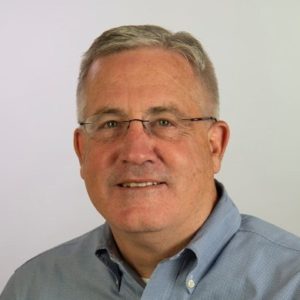A small house can mean a big difference, speakers say
Brian Gruber has fielded more than one telephone call from someone who has driven by new homes being constructed by Ridge Stone General Contractors, of which he is president. People request additional information about the “condos,” he said, including their price.
The catch? The new homes, built in clusters on cul-de-sacs, actually are skilled nursing and rehab neighborhoods for the non-profit Otterbein Senior Lifestyle Choices.
“These are 7,000-square-foot homes, but they are really designed to look like houses or condos,” Gruber said, adding that the scale of the neighborhood, the pitch of the roofs, the front doors and the building materials help the houses blend into the surrounding residential area. The exteriors of the homes have common elements—all roofs are black, all trim is white—but they don’t look identical. “People are amazed because it’s not what they’re used to seeing from a traditional nursing home.”
 Gruber and Susan McConn, MSN, LNHA, vice president of small house neighborhoods for Otterbein, discussed the small house model and its challenges at the recent Environments for Aging Conference in Anaheim, Calif. The small house model is “one of the most exciting models for skilled nursing that exists today” and represents the future of long-term care, McConn said. She described Otterbein, based in Lebanon, Ohio, as the country’s largest provider of small house care, with five skilled nursing and rehab neighborhoods in the western part of the state—the oldest is seven years old—and four more being developed. The company also offers continuing care retirement communities as well as home health and hospice services.
Gruber and Susan McConn, MSN, LNHA, vice president of small house neighborhoods for Otterbein, discussed the small house model and its challenges at the recent Environments for Aging Conference in Anaheim, Calif. The small house model is “one of the most exciting models for skilled nursing that exists today” and represents the future of long-term care, McConn said. She described Otterbein, based in Lebanon, Ohio, as the country’s largest provider of small house care, with five skilled nursing and rehab neighborhoods in the western part of the state—the oldest is seven years old—and four more being developed. The company also offers continuing care retirement communities as well as home health and hospice services.
“The whole small house model is to get away from that institutional nursing home and provide something better,” McConn said.
An Otterbein small-house neighborhood consists of five homes (one for rehabilitative stays of fewer than 30 days, and the others for long-term stays), each with 10 occupants, in a residential setting. Each home includes private, customizable suites for residents (all of which can support ceiling lifts, and two with lifts already present) as well as a common living room and dining, kitchen and spa/salon areas. (The “great room” concept means that residents have short walks to wherever they’d like to go, Gruber said.) Elders are free to use the fenced-in back patio and backyard—complete with gas grill, patio furniture and a garden area—whenever they wish. Care delivery is person-centered; residents determine their own schedules, and their preferences are honored.
“The houses probably are not as efficient as an institutional nursing home, but that’s OK for us,” McConn said.
Whole approach to living
The small house model is not just a design; it is a whole approach to living as well, with a language of its own. Residents are referred to as elders, and staff members—working in an organizational structure that McConn said is “very flat” and “not a bureaucracy”—have unique titles.
In every Otterbein home, two elder assistants work during the day, two work in the evening and one works at night. They are state-tested nursing assistants employed under the “universal worker” model and so are involved with dining, housekeeping, caregiving and other tasks. All elder assistants carry smartphones to receive messages, as needed, from pendants worn by the elders. Also, they use email as one way to communicate with administrators and other staff members.
Each neighborhood also has nurses—two during the day, two in the evening and one at night. They move from house to house, each carrying a bag with a blood pressure cuff, stethoscope, glucometer and other items. The nurses administer medication (usually twice a day) that is kept in locked cabinets in the elders’ rooms, eliminating the need for a medication cart.
Each neighborhood also includes a guide (administrator), a coach (usually a newly licensed administrator) to whom all elder assistants report, a healthcare coordinator (director of nursing), a quality-of-life coordinator who performs social services and activities duties, a housing coordinator who performs admissions functions, a business office coordinator, a maintenance person and a chaplain, since Otterbein is a faith-based organization. These employees (Otterbein refers to employees as partners) also move from house to house, taking their computers with them and working in the offices located in each house (one per house), none of which is assigned to any particular person or purpose, McConn said.
Resident choice
Dining is one way that resident choice is manifested, McConn said. (See this article to read about another experience with household dining.) Once a week, she explained, the elders meet with the elder assistant to talk about the menu for the next two weeks. The elder assistant enters food choice information into a computer, and a diet technician or dietitian subsequently reviews it. The elder assistant orders the food online, and it is delivered to the home. At meal time, the elder assistant prepares the food, which could mean a different meal for each resident.
Challenges
“People want to live where they’ve lived all their lives,” McConn said. “That’s part of why we decided to build in a residential neighborhood.”
Delivering skilled nursing in a residential area can pose challenges, however, she and Gruber said. Those challenges center on changing public perceptions of skilled nursing.
For instance, going through the zoning process can be difficult, Gruber noted, at least the first time a small house neighborhood is constructed in a geographic area. The process can ease somewhat after the first grouping of homes is built, he added, because government officials and residential neighbors gain a better understanding of the small house concept.
All houses must comply with the applicable codes and regulations related to construction of a commercial facility as well as the provision of nursing and rehabilitative care and safety and security, Gruber said. “You have all the things you have in a nursing home. It just doesn’t look like it when you first look,” he added.
The condo-like appearance of the homes also means that the organization’s marketing department works hard to help potential residents locate the neighborhoods and understand that skilled nursing can be delivered in such settings, McConn said.
Another challenge relates to contracted services, which for Otterbein include therapy and lab services.
“Therapists have to understand that we don’t wake people up, so you can’t come in and get everybody out of bed to do therapy at 8 o’clock in the morning. It doesn’t work that way,” McConn said. Similarly, lab workers initially want to arrive at 6 a.m. to conduct all of their work and then leave, she added. So the service providers with whom Otterbein contracts need to be retrained to align their efforts with the small house concept.
The model itself is designed to support therapy in the houses and neighborhood, McConn said. For instance, occupational therapists can use the actual kitchen to work with elders on their kitchen skills; elders can practice walking in hallways and, outside, via trips to the mailbox and stepping off and on curbs; and a drive-up area in front of the house allows for practice entering and exiting vehicles.
The short-stay house has more therapy equipment, such as weights and mats, she added, but elders in the long-term houses typically receive therapy services in their own homes.
A final challenge of the small house model is trying to avoid what McConn called “institutional creep.” “A lot of times, we just say, ‘So, would you do that at your house?’ If the answer is no, then we don’t do it here, either,” she said.
But the challenges are worth it for everyone involved, McConn said. Otterbein’s small house neighborhoods exceed state and federal quality benchmarks for antipsychotic drug and physical restraint use, rehospitalization and pain management, she said. The neighborhoods also experience lower staff turnover and higher family, resident and staff satisfaction, McConn said, and occupancy of the small houses is 95 percent compared with a state average of 86 percent for skilled nursing.
McConn and Gruber said they welcome the chance to help others implement the model successfully (find contact information in the links in this article). Otterbein, she pointed out, learned the ideal elder/elder assistant ratio to “keep it more like a family,” as well as other information, from a Green House community in Tupelo, Miss.
“We share information freely. …I want to get to the point where, someday, somebody says, ‘What was an institutional nursing home?’ ” McConn said.
I Advance Senior Care is the industry-leading source for practical, in-depth, business-building, and resident care information for owners, executives, administrators, and directors of nursing at assisted living communities, skilled nursing facilities, post-acute facilities, and continuing care retirement communities. The I Advance Senior Care editorial team and industry experts provide market analysis, strategic direction, policy commentary, clinical best-practices, business management, and technology breakthroughs.
I Advance Senior Care is part of the Institute for the Advancement of Senior Care and published by Plain-English Health Care.
Related Articles
Topics: Articles , Design , Executive Leadership , Facility management , Housing , Operations











